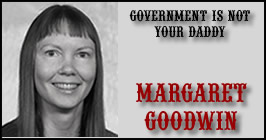OREGON'S BIG LAND USE SWINDLE
By
Margaret Goodwin
November 25, 2008
NewsWithViews.com
Thirty-five years ago, the Oregon State Legislature decided that government must have more control over private property. Oregon’s economy was evolving and its population was growing. Liberal reactionaries feared the ensuing development would encroach on lands traditionally used for forestry and farms. Progress inevitably leads to growth. If growth is determined to be bad, then progress must be constrained, if not halted altogether. Development also posed a threat to viewscapes for those who felt a moral obligation to preserve the aesthetic purity of other people’s property. The legislature’s solution was to establish centralized control of resources to ensure that everybody’s land was used “properly,” rather than leaving it to the vagaries of the free market and personal inclination. So, in 1973, they enacted the Oregon Land Use Act (Senate Bill 100).
The Oregon Land Use Act required every city and county in Oregon to implement a Comprehensive Plan, and created a taxpayer-funded bureaucracy, the Land Conservation and Development Commission, to impose mandatory statewide standards with which all Comprehensive Plans must comply. One of their goals was to prevent urban sprawl, so the LCDC mandated the establishment of Urban Growth Boundaries and restricted all new commercial and industrial development to within the UGBs . To enforce the perpetuation of the traditional economy, the LCDC required every county to “protect” any undeveloped land outside the UGBs by zoning it exclusively for forestry or agriculture, thereby precluding future development.
The LCDC conveniently absolved itself of accountability to the citizens whose land was arbitrarily rezoned, by declaring that it was the counties, not the LCDC, that determined the zoning of individual lots when drafting their Comprehensive Plans. Nevertheless, the LCDC reviewed every Comprehensive Plan to compel compliance with its mandatory standards, leaving the counties little latitude. Noncompliance would result in an “enforcement order” to cut off state funding of mandated county services until compliance was achieved.
Some counties didn’t have sufficient resources to individually notify property owners that their land had been rezoned, but merely published notices in the newspaper. Property owners who missed the notices, or didn’t read all the fine print, didn’t find out their zoning had changed until they applied for permits to develop their land, sometimes years after the fact. Naturally, there was a huge outcry from citizens whose property rights had been yanked out from under them. Thousands of people suffered tremendous losses of property value; many lost their nest eggs for retirement.
After 30 years of legal battles, the voters passed Measure 37 in 2004, allowing citizens who could prove a significant loss of real property value as a result of regulatory changes to claim compensation for their loss. The state or local government had the option to issue a waiver, in lieu of monetary compensation, allowing the property owners to use their land as it was zoned at the time they purchased it. In most of the cases in which a claim was verified and approved, counties opted to issue waivers.
So many Measure 37 claims were filed that the Department of Land Conservation and Development’s sweeping plans for statewide control of private property were threatened. So, the DLCD came up with a plan. In 2005, they declared that all Measure 37 claims required a state waiver in addition to the waiver issued by the county. Then they bemoaned that there were too many claims to process within the six month time limit specified by Measure 37, and they needed to extend the limit by a year. Hanging the pending claims out to dry for another year bought them time to draft Measure 49, which would effectively repeal Measure 37. The state spent a lot of taxpayer money on a campaign to vilify and characterize Measure 37 claimants as greedy developers and evil capitalists. Their strategy succeeded and Measure 49 passed.
Measure 49 is patently absurd, putting arbitrary limits on the number of houses a property owner can build. Claimants were pressured to apply for a “fast track” permit, which was only available during a six months time period after Measure 49 was passed. The fast track permit would allow a property owner to build a maximum of three houses, regardless of whether their parcel was five acres or 5,000 acres. If they didn’t apply for the fast track permit, the only other option was to petition for the right to build up to ten houses, but that would entail a more complicated and expensive process, with an onerous burden of proof that could only be satisfied if the land had actually been appraised for development before the Land Use Act was passed.
The DLCD also asserted that Measure 49 invalidated all existing Measure 37 waivers, except those that were already “vested” by having developed the property. However, the definition of vesting was left conveniently vague, and property owners who had spent millions of dollars developing their property were told they were not vested and could not continue with the development.
Furthermore, when one files a Measure 49 claim, there’s language in it that says no additional relief or compensation is due, and no waivers may be issued with regard to the property. It appears as though the DLCD is attempting to compel Measure 49 claimants to sign away any rights they may have been granted under Measure 37.
|
Subscribe to the NewsWithViews Daily News Alerts! |
In light of the recent US District Court ruling that Measure 37 waivers are Constitutionally protected contracts, it doesn’t take a crystal ball to foresee lots of litigation in the future of the DLCD, and of all the counties they put in the middle between them and the citizens they tried to swindle out of the use of their land. And the Oregon taxpayers will be paying for it. Why doesn’t the LCDC give up, go home, get their laws off of our land, and leave us alone?
Related
Article:
Let There Be
Light
� 2008 Margaret Goodwin - All Rights Reserved











